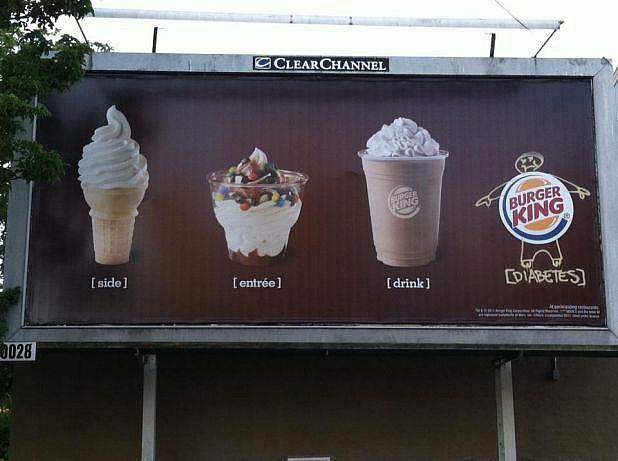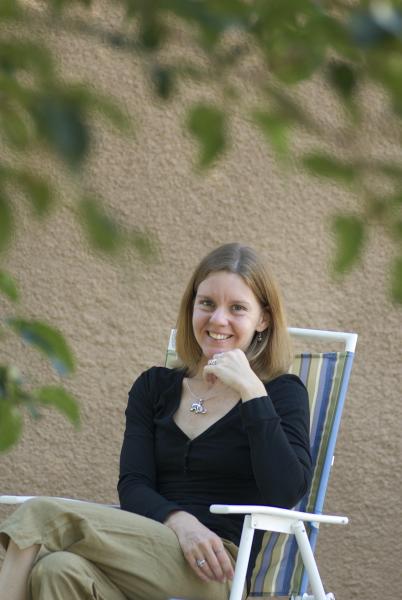Beyond Burger Blame: Food Writer Offers 5 Tips for Meeting the Obesity Challenge

 I asked my friend and colleague Karen Coates, an award-winning food writer, for her thoughts on Burger King's attempt to entice people to eat more dessert and the guerilla public health message that it prompted. She sent me a great set of tips for researchers examining obesity, health officials trying to address it and writers covering the epidemic.
I asked my friend and colleague Karen Coates, an award-winning food writer, for her thoughts on Burger King's attempt to entice people to eat more dessert and the guerilla public health message that it prompted. She sent me a great set of tips for researchers examining obesity, health officials trying to address it and writers covering the epidemic.
In my experience as a food writer and science journalist, that one Burger King billboard crystallizes much of the dilemma we face today in a world that pits the very real desire people have to live a healthy life against the overwhelming power of fast food marketing. In March, I attended the Knight Science Journalism Food Boot Camp at MIT, which drew several speakers who addressed many of the issues raised in the Burger King post. Here are some of the key points I think we need to consider when trying to put the public's well-being first.
1. Consider the chemistry. On the self-control issue, I think we have a tough time fighting the chemistry (how our brains react to fatty food) and fighting the money (in food marketing). I'm reminded of the talk by David Kessler, former FDA commissioner and author of The End of Overeating. He spoke about fat and sugar as salient stimuli that affect our brain circuitry. When people are conditioned to fat and sugar, their brain dopamine levels rise when they eat more of those items. It's a learned experience, so much so that the amygdala responds to the mere anticipation of food. Our dopamine levels rise when we smell the fries or even as we drive around the corner, heading closer to the restaurant. The human brain is wired to focus on those salient stimuli, and the food marketing industry taps into that. We are bombarded by cues to eat, and Kessler says knowledge isn't enough to counteract what happens in our brains. It's the same with drugs, alcohol and other stimuli, except that food is perhaps the most socially acceptable. How to change the status quo? Kessler says we have to shift our social norms. "I would try to make large portions uncool." [Coates wrote more about Kessler's talk for The Faster Times.]

2. Recalibrate normal. Some experts think we could start fighting obesity by changing the default options offered at fast-food restaurants. Salads instead of fries, fruit instead of ice cream, smaller portions instead of larger. Kelly Brownell, co-founder and director of the Rudd Center for Food Policy & Obesity at Yale, says according to one study almost 100 percent of employees stuck with the default when they were automatically enrolled into an organ donor program through their pension plans. But when they had to opt into that program, less than half did. That's the power of defaults. If McDonald's sells more salads instead of fries, that alone won't solve the nation's obesity crisis. But it might help.
3. Put less emphasis on willpower and stop the blame game. Many of the speakers at MIT think the odds are stacked against individuals. "Very few people choose to be overweight. It's something that happens to us. For most of us, it happens very gradually," says Margo Wootan, director of nutrition policy at the Center for Science in the Public Interest. Willpower is not enough. "There's not a shred of evidence to show that willpower has declined," she says. "Personal responsibility alone is not enough." Brownell points to the vast disparities in funding. The Robert Wood Johnson Foundation, the largest contributor to a nationwide anti-childhood obesity campaign, contributes $100 million annually. But the food marketing industry had spent that much by Jan. 4 of this year, he says. "It's really not much of a fair fight."
4. Forget the price tag. When you talk about the element of snobbery that comes into play when people blame the Burger Kings of the world for the obesity crisis, it's true. The high-end bistro burger might very well come from the same cow as the Burger King Whopper. Actually, it might come from the same 10,000 cows, whose parts are mixed and blended in processing facilities where grinders handle up to 30 tons of meat at a time. Unless certified organic, biodynamic or traceable to a specific farm, the average burger likely comes from one of the many factories responsible for processing a large share of the world's meat. Serve it on china and charge $15 or put it in a wrapper and hand it through the drive-through window - it's the same thing.
5. Think globally. I found the recent study on how perceived status might relate to portion sizes fascinating. The findings mirror what I've seen in developing countries across Asia. As the middle class expands, people's diets grow heavier on meat and fast food. Food has always been a status symbol in societies that traditionally lacked enough of it. Likewise, a big belly is something to admire. Fat and portion size are symbols of wealth and success. Of course, those dietary shifts come with their own American-sized troubles. Between 2000 and 2030, Brownell says, diabetes rates are expected to rise 75 percent in China and 134 percent in India.
Coates is the 2011 T. Anthony Pollner Distinguished Professor in The University of Montana School of Journalism. A graduate of the University of Montana (like me), she writes about food regularly for her site Rambling Spoon, which was a finalist for the Best Culinary Travel Blog by Saveur last year. You also may have seen her work in Archaeology, The Faster Times and Gourmet. Or you may have read one of her books. She has authored Cambodia Now: Life in the Wake of War and co-authored Pacific Lady: The First Woman to Sail Solo Across the World's Largest Ocean. She and her husband, freelance photojournalist Jerry Redfern, have two books coming out: Eternal Harvest: The Legacy of American Bombs in Laos and This Way More Better: Stories and Photos from Asia's Back Roads.
Photo credit: Peter Speyer
